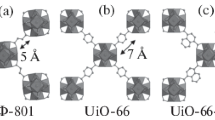Abstract
New mononuclear and hetero-binuclear MOFs derived from the reaction of 1,4-bis[(3,5-dimethyl)pyrazole-4-yl]benzene (H2DPB) with zinc nitrate or mixture of zinc and cobalt nitrates have been synthesized solvothermally from DMF or ethanol. The crystal structure of Zn(DPB) (1) indicates that it crystallizes in cubic system, with cell parameters, a = b = c = 6.7536 Å and α = β = γ = 90°. Tetrahedral structure around 1D Zn atoms run parallel to b axis is observed. Zn(DPB) (2) isolated from DMF crystallizes in monoclinic system, with cell parameters, a = 14.8865, b = 9.8392 and c = 10.8285 Å and α = γ = 90o and β = 93.05°. The results showed that Zn(DPB) (1) and CoZn(DPB) (3) MOFs isolated from ethanol are thermally and mechanically more stable than Zn(DPB) (2) and CoZn(DPB) (4). Pore texture shows that the highest BET surface area belongs to CoZn (DPB) (3). The compound Zn(DPB) (1) does not lose its crystallinity even after applying 0.2 GPa stress. Adsorption of nitrogen indicated the presence of type I isotherm characteristic to permanent microporosity. Compounds (1) and (3) do not lose their porosity under mechanical stress.









Similar content being viewed by others
References
Jiang C, Song L, Jiao CL, Zhang J, Sun L, Xu F, Zhang H, Xu Q, Gabelica Z. Determination of heat capacities and thermodynamic properties of two structurally unrelated but isotypic calcium and manganese(II) 2,6-naphthalene dicarboxylate-based MOFs. J Therm Anal Calorim. 2011;103:1095–103.
Alghool S, Slebodnick C, Karpin G. Supramolecular structure of Cu(II) and Zn(II) complexes based on 2,2′:6′,2″-terpyridine, thermal and biological studies. J Therm Anal Calorim. 2014. doi:10.1007/s10973-014-4235-z.
Vargas DP, Giraldo L, Moreno-Piraján JC. Calorimetric study of the CO2 adsorption on carbon materials. J Therm Anal Calorim. 2014;117:1299–309.
Tonigold M, Lu Y, Bredenkotter B, Rieger B, Bahnmuller S, Longstien G, Volkmer D. Heterogeneous catalytic oxidation by MFU-1: a cobalt(II)-containing metal-organic framework. Angew Chem Int Ed. 2009;48:7546–7550.
Ernest S. Advances in nanoporous materials, vol. 1. 1st ed. Elsevier: Amsterdam; 2009.
Sun Y, Yu H, Wang L, Ding W, Ji J, Chen Y, Ren F, Tian Z, Zhao Y, Huang L, Ren P, Tong R. Synthesis of three coordination polymer microspheres and their application in hydrogen storage. J Alloys Compd. 2014;585:667–73.
Fernández-Zapico E, Montejo-Bernardo J, D’Vries R, García JR, García-Granda S, Rodríguez Fernández J, Pedro I, Blanco JA. Phase stability and magnetic properties of a new cobalt(II) coordination polymer based on 2-carboxyethylphosphonate and 1,10′-phenanthroline. J Alloys Compd. 2012;536:S507–10.
Tabacaru A, Pettinari C, Masciocchi N, Galli S, Marchetti F, Angjellari M. Pro-porous coordination polymers of the 1,4-bis((3,5-dimethyl-1Hpyrazol-4-yl)-methyl)benzene ligand with late transition metals. Inorg Chem. 2011;50:11506–13.
Yaghi OM, Li G. Selective binding and removal of guests in a microporous metal-organic framework. Nature. 1995;378:703–6.
Saha D, Zacharia R, Lafi L, Cossement D, Chahine R. Synthesis, characterization and hydrogen adsorption on metal-organic frameworks Al, Cr Fe and Ga-BTB. Chem Eng J. 2011;17:1517–25.
Saha D, Wei Z, Deng S. Hydrogen adsorption equilibrium and kinetics in metal-organic framework (MOF-5) synthesized with DEF approach. Sep Purif Technol. 2009;64:7479–587.
Rurack K, Martinez-Manez R. The supramolecular chemistry of organic-inorganic hybrid materials. New york: Wiley; 2010.
Ramirez F, Bhatia SB, Patwardhan AV, Smith CP. Molecular rearrangements during solvolyses of pentaoxyphosphoranes polyketones derived from phthalaldehyde and terephthalaldehyde. J Org Chem. 1967;32:3547–51.
Putz H, Schon JC, Jansen M. Combined method for ab initio structure solution from powder diffraction data. J Appl Cryst. 1999;32:864–70.
Crystal Impact GbR, Endeavour 1.7, Internet: http://www.crystalimpact.com/endeavour.
Hyperchem 7, developed by Hypercube Inc. 2002.
Stewart JJP. Optimization of Parameters for Semiempirical Methods II. Applications. J Comput Chem. 1989;10:221.
Nakamoto K. Infrared spectra of inorganic and coordination compounds. NewYork: John Wiley; 1970.
Ye S, Neese F. Quantum chemical studies of C-H activation reactions by high-valent nonheme iron centers. Curr Opin Chem Biol. 2009;13:89.
Klug H, Alexander L, editors. X-Ray diffraction procedures. New York: Wiley; 1962.
Gonzalez Henrıquez CM, Terraza CA, Tagle LH, Gonzalez AB, Volkmann UG, Cabrera AL, Ramos-Moore E, Retamal MJ. Inclusion effect of gold and copper particles in a poly(amide) matrix that contains a thiophene moiety and Si or Ge atoms in the main chain. J Mater Chem. 2012;22:6782–91.
Kondo M, Shimamura M, Noro S, Minakoshi S, Asami A, Seki K, Kitagawa S. Microporous materials constructed from the interpenetrated coordination network structures and methane adsorption properties. Chem Mater. 2000;12:1288–99.
Seki S, Takamizawa S, Mori W. Design and gas adsorption property of a three-dimensional coordination polymer with a stable and highly porous framework. Chem Lett. 2001;30:332–3.
Rosi NL, Eckert J, Eddaoudi M, Vodak DT, Kim J, O’Keeffe M, Yaghi OM. Hydrogen storage in microporous metal-organic frameworks. Science. 2003;300:1127–9.
Chen B, Eddaoudi M, Hyde ST, O’Keeffe M, Yaghi OM, Interwoven metal-organic framework on a periodic minimal surface with extra-large pores. Science. 2001;291:1021–3.
Li H, Eddaoudi M, Groy TL, Yaghi OM. Establishing microporosity in open metal- organic frameworks: gas sorption isotherms for Zn(BDC) (BDC = 1,4-benzenedicarboxylate). J Am Chem Soc. 1998;120:8571–2.
Feréy G, Mellot-Draznieks C, Serre C, Millange F, Dutour J, Surble S, Margiolaki IA. Chromium terephthalate-based solid with unusually large pore volumes and surface area. Science. 2005;309:2040–2.
Chui SSY. F. Lo S M, Charmant J P H, Orpen A G, Williams I D, A chemically functionalizable nanoporous material [Cu3(TMA)2(H2O)3]. Science. 1999;283:1148–50.
Acknowledgements
The author thanks Prof. Jorge A. R. Navarro and his research group Carmen Montoro, Elsa Quartapelle, Sara Rojas and the Inorganic Chemistry Department, Granada University, Spain, for their cooperation. The author thanks also Dr. Mostafa A. Hussein, Chemistry Department, Faculty of Science, Port-Said University.
Author information
Authors and Affiliations
Corresponding author
Rights and permissions
About this article
Cite this article
Hosny, N.M. Solvothermal synthesis, thermal and adsorption properties of metal-organic frameworks Zn and CoZn(DPB). J Therm Anal Calorim 122, 89–95 (2015). https://doi.org/10.1007/s10973-015-4721-y
Received:
Accepted:
Published:
Issue Date:
DOI: https://doi.org/10.1007/s10973-015-4721-y




